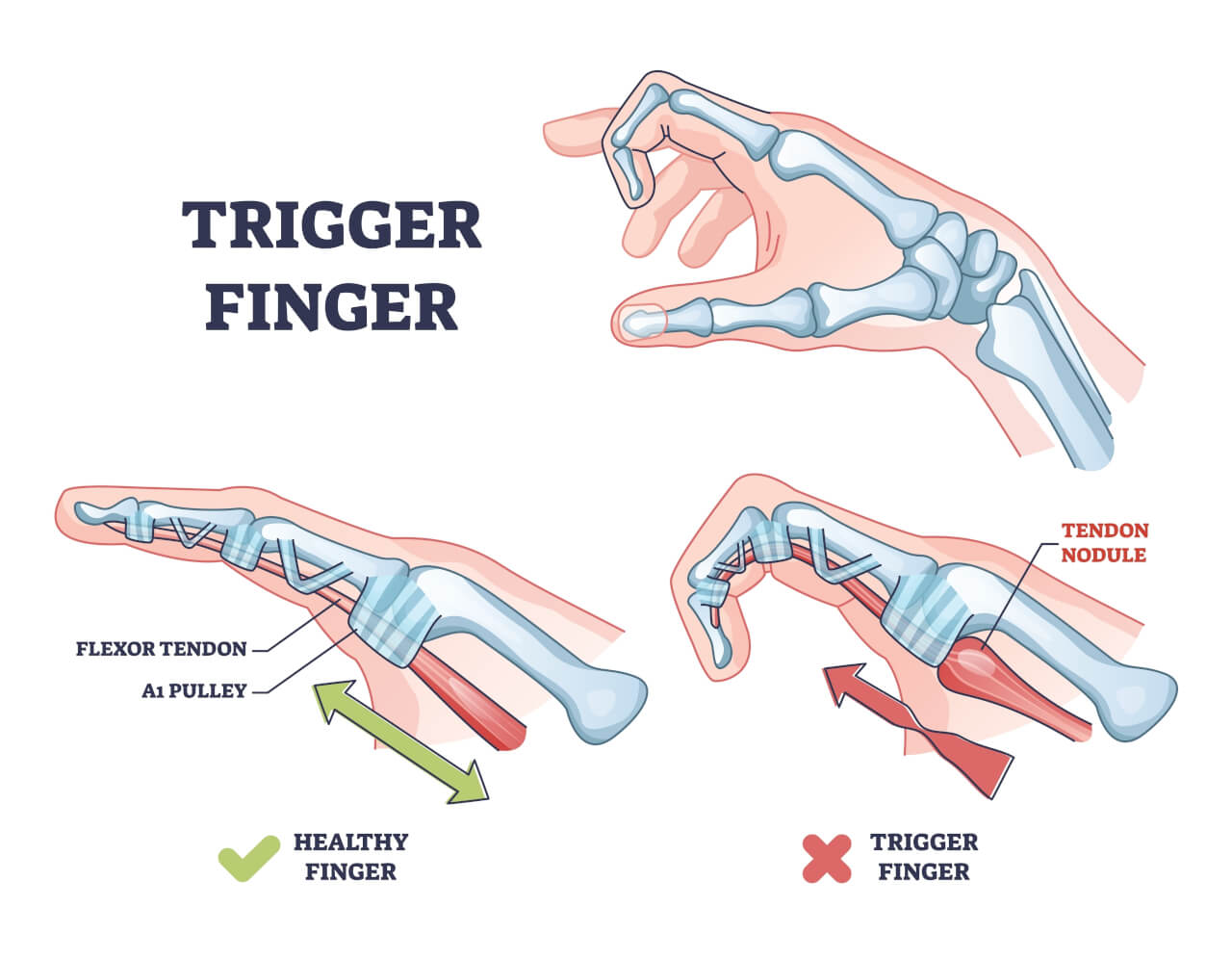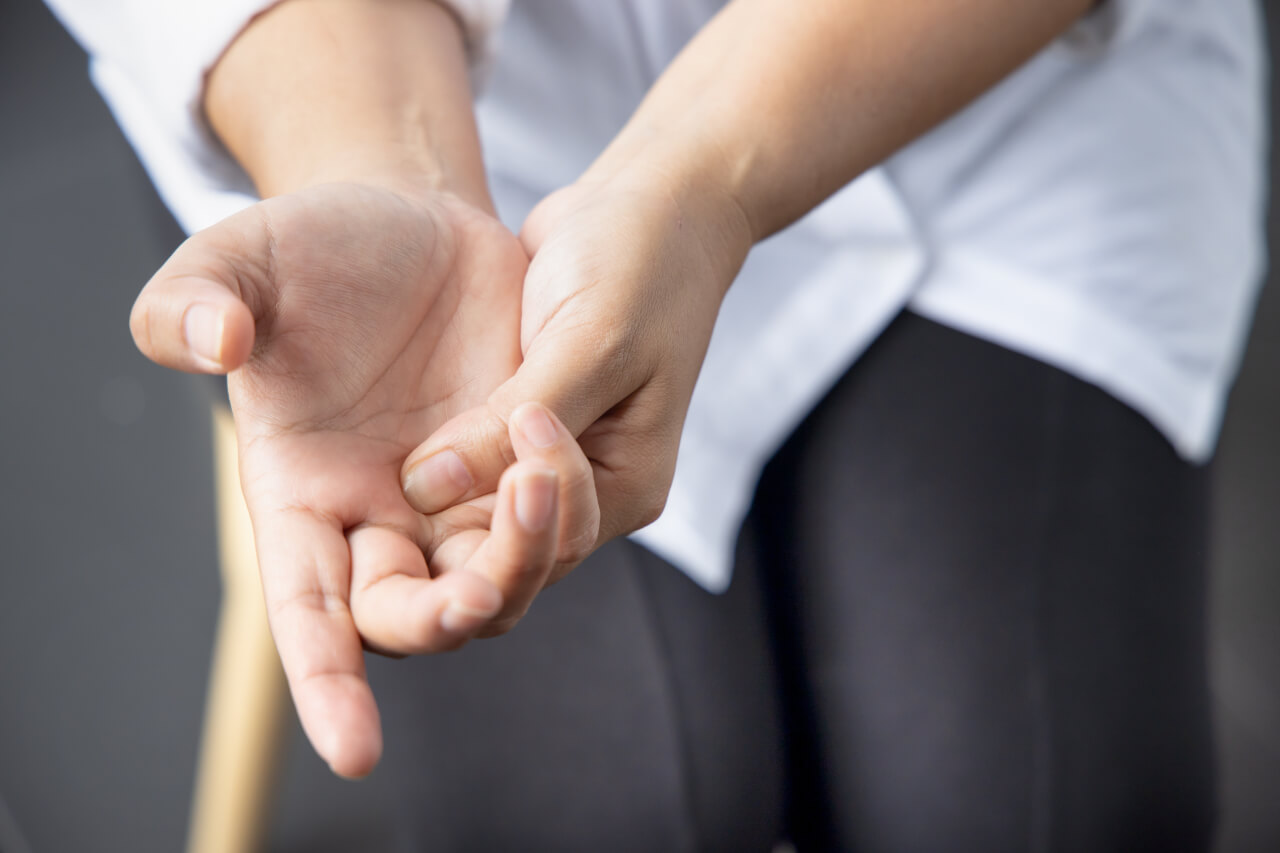Trigger Finger
Home » Treatment » Hand & Wrist » Trigger Finger
What is Trigger Finger?
Trigger finger, medically known as stenosing tenosynovitis (stuh-NO-sing ten-o-sin-o-VIE-tis), is a common hand condition that affects the tendons and fingers. It causes pain, stiffness, and difficulty in finger movement.
Trigger finger is a condition in which one or more fingers, most commonly the ring finger or thumb, become locked in a bent position and may snap or pop when straightened. It results from inflammation of the flexor tendons and their surrounding sheath in the affected finger. The tendons, responsible for bending the fingers, glide through a narrow tunnel called the tendon sheath. When the sheath becomes inflamed or thickened, it restricts the smooth movement of the tendon, leading to the characteristic triggering sensation.
If you have a question about whether your condition should be treated by one of our hand therapists, call Restored Hope Hand Therapy at (928) 275-2201.

Causes of Trigger Finger
Several factors contribute to the development of trigger finger:
- Repetitive Hand Movements: Frequent and forceful use of the hand and fingers, such as gripping tools or using a keyboard for extended periods, can lead to overuse injuries that may trigger the condition.
- Health Conditions: Certain health conditions are associated with an increased risk of developing trigger finger. These include diabetes, rheumatoid arthritis, and gout.
- Age and Gender: Trigger finger is more common in individuals between the ages of 40 and 60. Additionally, women are more likely to develop this condition than men.
- Genetics: There may be a genetic predisposition to trigger finger, as it tends to run in families.
Trigger Finger Treatment in Prescott, AZ
Effective management of trigger finger involves a variety of treatment options, which may be used alone or in combination, depending on the severity of the condition. The primary goal of treatment is to relieve pain and restore normal finger movement.
- Rest and Activity Modification: Initially, resting the affected hand and avoiding activities that exacerbate the condition can provide relief. A splint may be recommended to keep the finger immobilized.
- Medications: Nonsteroidal anti-inflammatory drugs (NSAIDs), such as ibuprofen, can help reduce pain and inflammation.
- Corticosteroid Injections: A corticosteroid injection into the tendon sheath can provide significant relief from inflammation. This treatment is especially effective in mild to moderate cases.
- Physical Therapy: At Restored Hope Hand Therapy, we can help with exercises to improve the finger’s range of motion and strengthen the hand muscles.
- Splinting: In some cases, wearing a custom splint to keep the affected finger extended can help relieve symptoms and encourage proper healing. Hand therapists at Restored Hope are experts in building a custom splint for each patient.
- Percutaneous Release: For more severe cases, a minimally invasive procedure called percutaneous release may be performed. It involves the use of a needle to cut the tendon sheath, allowing the tendon to move freely.
- Open Surgery: In rare and severe cases, open surgery is required to release the affected tendon and sheath. This is usually considered when other treatments have been unsuccessful.

Treatment Goals
The goals of trigger finger treatment are multifaceted and focused on improving the patient’s quality of life. These goals include:
- Pain Relief: Alleviating pain and discomfort is one of the primary treatment objectives. By reducing inflammation and allowing the tendon to move freely, patients experience relief from pain.
- Restoration of Function: The ability to move the affected finger(s) without restriction or triggering is a crucial goal. This allows individuals to perform daily activities and tasks with ease.
- Prevention of Recurrence: Addressing the root causes of trigger finger, such as overuse, underlying medical conditions, or genetic factors, is essential to prevent the condition from recurring.
- Minimizing Disability: By improving finger function, treatment aims to minimize the disability associated with trigger finger, allowing individuals to resume their regular activities and work.
- Avoiding Complications: Timely and appropriate treatment helps prevent complications, such as permanent finger deformities and decreased hand function.
Prognosis
The prognosis for individuals with trigger finger is generally positive, especially when the condition is identified and treated early. Most cases respond well to non-surgical treatments like splinting, medication, and corticosteroid injections. However, the prognosis can vary based on several factors:
- Severity: Mild to moderate cases typically respond better to non-surgical treatments. Severe cases may require more invasive procedures like percutaneous release or open surgery.
- Timely Intervention: Early diagnosis and treatment yield better outcomes. Delayed treatment can result in more chronic and debilitating conditions.
- Underlying Health Conditions: The presence of coexisting health conditions, such as diabetes or rheumatoid arthritis, may complicate treatment and influence the prognosis.
- Compliance: Patient compliance with treatment recommendations, including rest, hand exercises, and follow-up appointments, plays a significant role in achieving positive outcomes.
Complications
While trigger finger is generally a treatable condition, complications can arise if left untreated or if treatment is not successful. These complications may include:
- Permanent Deformity: Without proper treatment, prolonged inflammation and finger locking can lead to permanent deformities, making it difficult to use the affected finger.
- Decreased Hand Function: Untreated trigger finger can result in reduced hand function and dexterity, impacting one’s ability to perform daily tasks.
- Chronic Pain: The ongoing pain and discomfort associated with trigger finger can become chronic if the condition is not addressed.
- Limited Quality of Life: Reduced hand function and ongoing pain can significantly affect a person’s quality of life, hindering their ability to work, participate in recreational activities, or perform essential daily tasks.

Prevention
While not all cases of trigger finger can be prevented, there are steps individuals can take to reduce their risk and promote hand health:
- Hand Ergonomics: If your job or hobbies involve repetitive hand movements, practice good ergonomics by taking breaks and using proper hand posture.
- Rest and Stretching: Allow your hands and fingers to rest regularly during activities that require repetitive hand movements. Incorporate hand and finger stretches into your routine.
- Health Maintenance: If you have an underlying health condition like diabetes or rheumatoid arthritis, work closely with your healthcare provider to manage it effectively.
- Weight Management: Maintaining a healthy weight can reduce the strain on your hand joints and tendons.
Early intervention and appropriate treatment can yield positive outcomes, but complications can arise if left untreated. By understanding the causes, treatment options, and prevention measures, individuals can take proactive steps to maintain hand health and reduce the risk of developing trigger finger. If you suspect you have trigger finger or are experiencing symptoms, consult a hand surgeon for a proper diagnosis and contact Restored Hope Hand Therapy for a tailored treatment plan.
Hand & Wrist Therapy Options
individualized-specific therapy programs to offer you the best possible results.
Hand & Wrist
- Arthritis
- Carpal & Cubital Tunnel Syndromes
- De Quervain's Tenosynovitis
- Dislocations
- Dupuytren's Contracture
- Flexor Tendon Injuries
- Fractures
- Ganglion Cyst
- Ligament Tears
- Mallet Finger
- Sprains & Strains
- Tendon Transfer Neuro Re-education
- Trigger Finger
- Wrist Sprain

